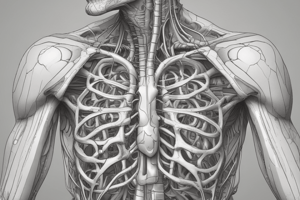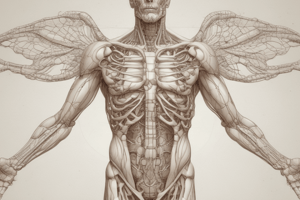Podcast
Questions and Answers
What is the name of the condition caused by a tumor or other space-occupying lesion in the superior mediastinum?
What is the name of the condition caused by a tumor or other space-occupying lesion in the superior mediastinum?
- Mediastinal compression syndrome
- Mediastinal syndrome (correct)
- Superior mediastinal syndrome
- Thoracic aortic syndrome
Which nerve compression leads to hoarseness of voice?
Which nerve compression leads to hoarseness of voice?
- Phrenic nerve
- Left recurrent laryngeal nerve (correct)
- Vagus nerve
- Sympathetic trunk
What is the result of tracheal compression in the superior mediastinum?
What is the result of tracheal compression in the superior mediastinum?
- Dysphagia
- Venous congestion
- Dyspnea (correct)
- Hoarseness
Which of the following structures passes through the thoracic inlet?
Which of the following structures passes through the thoracic inlet?
What is the result of compression of the superior vena cava in the superior mediastinum?
What is the result of compression of the superior vena cava in the superior mediastinum?
What is the primary function of the nerves in the superior mediastinum?
What is the primary function of the nerves in the superior mediastinum?
What is the effect of compression of the esophagus in the superior mediastinum?
What is the effect of compression of the esophagus in the superior mediastinum?
Which of the following structures is NOT found in the superior mediastinum?
Which of the following structures is NOT found in the superior mediastinum?
What is the term for the network of veins in the superior mediastinum?
What is the term for the network of veins in the superior mediastinum?
What is the location of the lymph nodes in the superior mediastinum?
What is the location of the lymph nodes in the superior mediastinum?
Flashcards
Mediastinal syndrome cause
Mediastinal syndrome cause
A condition resulting from a tumor or space-occupying lesion in the superior mediastinum.
Hoarseness cause
Hoarseness cause
Compression of the left recurrent laryngeal nerve.
Tracheal compression effect
Tracheal compression effect
Causes difficulty breathing (dyspnea).
Thoracic inlet structures
Thoracic inlet structures
Signup and view all the flashcards
SVC compression effect
SVC compression effect
Signup and view all the flashcards
Superior mediastinum nerve function
Superior mediastinum nerve function
Signup and view all the flashcards
Esophageal compression effect
Esophageal compression effect
Signup and view all the flashcards
Superior mediastinum non-structure
Superior mediastinum non-structure
Signup and view all the flashcards
Superior mediastinum venous network
Superior mediastinum venous network
Signup and view all the flashcards
Superior mediastinum lymph node location
Superior mediastinum lymph node location
Signup and view all the flashcards
Study Notes
Contents of the Middle Mediastinum
- Arteries: thoracic aorta, manifold branches
- Veins: azygos, hemiazygos, and accessory hemiazygos venous system
- Nerves: forming the oesophageal plexus, autonomic sympathetic trunks, and the glanchnic nerves
- Tubes: oesophagus, thenar ducting is tight sido
- Lymph nodes: posterior mediastinal lymph nodes
Mediastinal Syndrome
- A clinical condition caused by compression of the contents of the superior mediastinum
- Caused by a space-occupying lesion (e.g. tumours, enlarged lymph nodes, or an orthotopic thyroid gland)
- Manifestations depend on the structures compressed
- Vessels: compression leads to venous congestion on the upper limb, hand, and neck
- Trachea or oesophagus compression leads to dyspnoea or dysphagia, respectively
- Nerves: compression of the left recurrent laryngeal nerve leads to hoarseness of voice
Studying That Suits You
Use AI to generate personalized quizzes and flashcards to suit your learning preferences.




